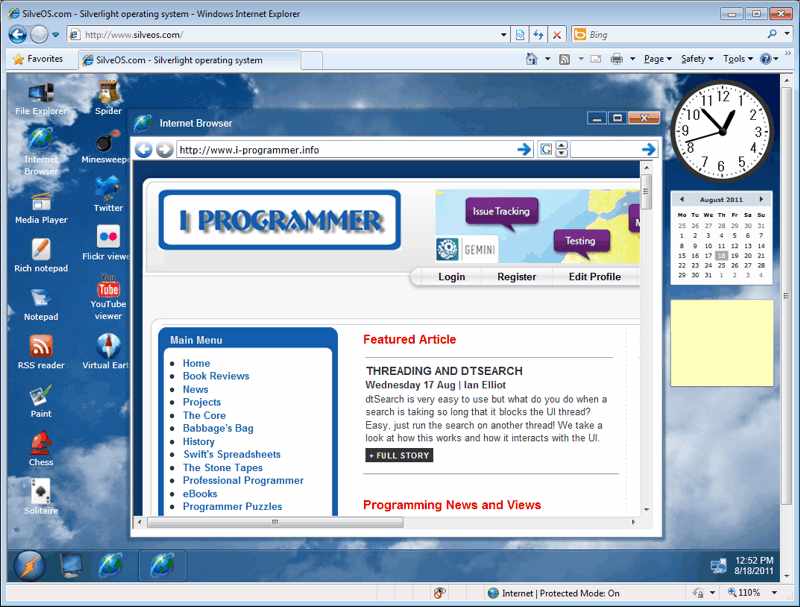| Windows in Silverlight |
| Written by Mike James | |||
| Thursday, 18 August 2011 | |||
|
SilveOS is proof of concept of the idea that Silverlight is Windows in a browser. You might expect that this amazing software, which challenges Chrome among others, would be from Microsoft - but no it is from a tiny operation that is both undersupported and underfunded. In earlier I Programmer articles discussing the completely insane nature of the idea that Microsoft might dump Silverlight or indeed the whole of .NET the point that Silverlight is Windows in a browser has been made a number of times. However, this throwaway line wasn't explained in any great detail. The point is that Silverlight is .NET inside the browser and, if you assume that all modern Windows apps should be written in .NET, this means that any modern Windows app should run in Silverlight. Hence Silverlight is Windows in a browser. This is a very neat idea but it sounds a bit abstract and you might even doubt that it is true in any strict sort of sense. How can Silverlight provide all of the facilities of the operating system? Of course it can't because it can only provide those that have been translated into the .NET Silverlight class library - but this is a very wide range of facilities from file system to multimedia. All it lacks is someone to create a Silverlight version of the Shell and versions of many of the standard utilities such as the file manager and so on. SilveOS is the proof of concept you have been waiting for. It started life about a year ago under the name Windows4All in the CodePlex but was recently ejected from this home, superficially because its name infringed some intellectual property or other. Now it is renamed SilveOS and it is available for free for you to try out. All you need is a browser that has the Silverlight plugin installed. If you can see it in action for real the video below gives you some idea of what an early version looked like:
The only problem is that there is very little in the way of documentation - just a forum where you can ask questions. In use it looks a lot like Windows 7 and it comes with the following utilities:
But the list is being added to all the time. I urge you to try it out - it is amazing. Especially the recursive experience of using the SilveOS Internet Explorer to browse a website while the whole thing runs in whatever browser you are using to run it. And don't try running SilveOS in the SilveOS browser that way madness lies....
What about developing applications for it? The big problem is that there is no documentation - but wait! If you have been following the description of the architecture of SilveOS you will realize that you don't need any! SilveOS is just a collection of utilities running under Silverlight - each one in its own Silverlight window. To create an application for SilveOS you simply write a Silverlight application. This means you probably already have a SilveOS application you can upload and try out. Notice that building SilveOS is an achievement but it isn't as difficult as you might think. As explained Silverlight is essentially already an implementation of Windows and to extend it to a full OS isn't as tough as you might guess. This raises the question of why Microsoft haven't done this? In Silverlight they almost have an out of the box challenger to Chrome or any other WebOS or "WebTop". Of course the problem is that something like SilveOS is a challenge to Windows and as such probably not a good idea from Microsoft's position. There is also the possibility that Microsoft really isn't interested in Silverlight and prefers HTML5/JavaScript. If this is that case I would suggest that Microsoft try the task of building a JavaScript WebOS that not only looks like Windows in a browser but also runs Windows applications - this is tough, very tough. Contemplating the exercise might just give Microsoft an insight into why Silverlight is special. So what about the real possibilities of SilveOS? The big problem is that it currently seems to be underfunded and undersupported. Its development team is working hard but hasn't said when it will be open sourced, only that it's status is "freeware". Until its status is sorted out a little more clearly I think you have no choice but to regard it as a proof of concept that has reached a first beta. More information:silveos - this will take you to the SilveOS operating system which will start running as long as the browser you are using has the Silverlight plugin. The closed down windows4all codeplex site has some information on the early stages of the project. Further reading:Dumping .NET - Microsoft's Madness Windows and .NET - the coming storm WPF & Silverlight at risk from Microsoft's passion for HTML5
If you would like to be informed about new articles on I Programmer you can either follow us on Twitter or Facebook or you can subscribe to our weekly newsletter.
|
|||
| Last Updated ( Thursday, 18 August 2011 ) |

